本文
<Online Exhibition>The Birth of Hiroshima, Peace Memorial City PART1
CONTENTS
PART1
Introduction
1. Hiroshima as a Castle Town
2. Modern Hiroshima
3. Hiroshima in Wartime
The history of Hiroshima as a city began in 1589, when feudal lord (daimyō) Mōri Terumoto, who ruled Western Honshū, had Hiroshima Castle built. Later, the castle would become home to Lord Fukushima, and then Lord Asano as Hiroshima developed into the center of the Hiroshima Domain and was one of the biggest cities in the Edo Period (1603-1867).
After the Meiji Restoration, as the central city of Hiroshima Prefecture, Hiroshima began to evolve into an early modern city. However, it was also a military city: a hub for the army. A garrison and military headquarters were established inside of Hiroshima Castle grounds, and when the First Sino-Japanese War began, the Imperial Headquarters moved there.
As the Second Sino-Japanese War became the Pacific War, citizens were forced into war, mobilized to fight, welcome and send off soldiers, and work in military factories, while school children were evacuated to safe places outside of the city.
Then, at 8:15 am on August 6, 1945, the first atomic bomb to be used in warfare was dropped on Hiroshima. Countless lives were lost, and the city was reduced to rubble in an instant. The townscape, reminiscent of its time as a castle town, and the traditions and culture that had been handed down even after the Meiji Era, also received significant damage in the bombing.
This exhibition will take a look at the history of Hiroshima: its development as a castle town before the bombing, brave recovery from the ashes of the atomic bombing, and its current state as a peace memorial city that conveys the reality of the atomic bombing and appeals for peace. The exhibit will focus on the different eras of Hiroshima’s history as seen through changes in the cityscape, as well as the lives of the citizens, using materials such as photos and illustrated maps.
As the threat of nuclear weapons use has increased due to factors such as the Russian invasion of Ukraine, the G7 Summit will be held in Hiroshima from May 18 to 21 this year, making it the first G7 Summit to be held in an atomic-bombed city. In order to clearly convey the history of Hiroshima to the many visitors coming to our city from across Japan and the world, we have employed visual aids and translated the explanations into English.
We hope that this exhibition will remain in the hearts of those who keep the importance of the culture of peace in mind and work to promote it.
When Mōri Terumoto began building Hiroshima Castle on the delta above the Ōta River in 1589, the area known as the former city limits of current Hiroshima was nothing but shallow seas. The name “Hiroshima” began to be used in this period. Before then, the area was known as Aki or Aki-no-Kuni.
It is believed that the castle town was copied from the castle towns of Kyoto and Osaka. The foundations of the town were almost completely formed during the reign of Fukushima Masanori, who ruled the Hiroshima Domain after Lord Mōri in the Edo Period. The castle was surrounded by samurai residences, and these residences were surrounded by towns where craftspeople and merchants lived, as well as temples and shrines.
In 1619, Asano Nagaakira became lord of the Hiroshima Domain, and for 12 generations over 250 years, the castle town prospered as the center of politics, economics, and culture in the domain. Thanks to land reclamation, new lands expanded out toward the sea and were incorporated into the castle town, and the population around 1820 was nearly 70,000, making it one of the biggest cities of the time, behind Edo, Osaka, Kyoto, Nagoya, and Kanazawa. Streets were lined with bustling shops and the docks on the riverbanks, a hub for transport via water, were a flurry of activity. Nakajima-hon-machi, located along the Saigoku Kaidō Highway, was the biggest shopping and entertainment district in the castle town.
1 Map of the Hiroshima Castle Town in Kan'ei Period(1624-1643, the early Edo Period)
The castle town spreading out from the samurai residences ringing the castle, and commercial areas populated by craftsmen and merchants, as well as temples and shrines.
Yellowish green area: samurai residences
Gray area: commercial areas
Yellow area: temples
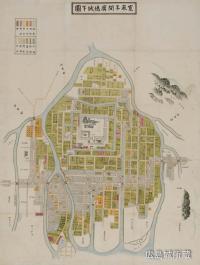
Around 1624-1643 / Map / Collection of Hiroshima Castle
2 Map of the Hiroshima Castle Town in the Early Edo Period
Yellow area: commercial areas
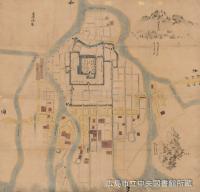
Around 1645-1657 / Map / Collection of the Hiroshima City Central Library
Hiroshima City Central Library
https://adeac.jp/hiroshima-city-lib/viewer/mp000030-200010/500/<外部リンク>
3 Map of the Hiroshima Castle Town in Early 18th Century
Black area: commercial areas
Red area: temples
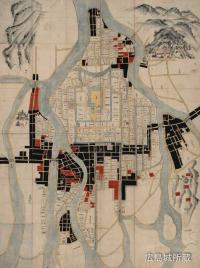
Early 18th century (the mid-Edo Period) / Map / Collection of Hiroshima Castle
4 Map of the Hiroshima Castle Area (One part of “Geihan Hiroshima Joka no Yozu”, detailed maps of each house)
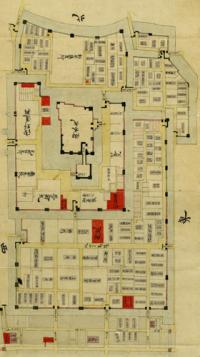
Late 19th century (the early Meiji Era) / Map / Collection of the Hiroshima Municipal Archives
5 Illustration of the Hiroshima Castle Town Viewed from the North West(“Geiyou Hiroshima Chausu-yama yori Chobo Ryakuzu” Illustration of the Hiroshima castle town drawn from Mt. Chausu-yama)
The island on the center right is Ujina-jima, present Motoujina, the place of G7 Hiroshima Summit.
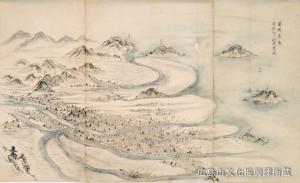
The middle 19th century (the end of Edo Period) / Illustration / Collection of Cultural Promotion Division, City of Hiroshima
6 The Bustle of the Castle Town
It's one part of “Folding screen depicting Hiroshima castle town”.
Nakajima-hon-machi , present Hiroshima Peace Memorial Park, was the busiest quarters of Hiroshima Castle town.
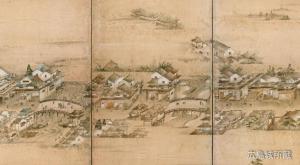
Around 1804-1818 / Folding screen / Collection of Hiroshima Castle
7 The Prospering Commercial Quarters East of the Present Peace Memorial Park

Original 1809 / From the Picture of the illustration “Kozan-ichiran-zu”
8 “Otomo-bune” Boats on Honkawa River and the Audience
“Otomo-bune” were accompanying boats of the goddess's boat called “Kangen-bune (Goza-bune)” that returned to Miyajima during the Kangensai Festival of Itsukushima Shrine. Each town in Hiroshima Castle had created, these boats at one time.

Original 1809 / From the Picture of the illustration “Kozan-ichiran-zu”
9 The Illustration of “Sunamochi-kasei”
Before the Modernizing periods, riverboats were main transport way for goods and passenger. To maintain transportation and keep rivers from sand accumulation, residents regularly dredged up rivers. Around this period, this dredging was becoming like a festival called “Sunamochi-kasei”. People gathered and praised their hard work.
This Illustration drawn the dredging up Honkawa river in 1862.
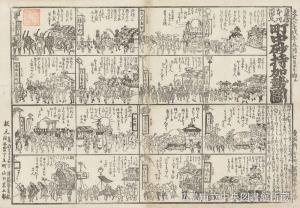
1862 / Woodblock print / Collection of Hiroshima City Central Library
Hiroshima City Central Library
https://adeac.jp/hiroshima-city-lib/viewer/mp21000280-200010/674/<外部リンク>
The Meiji Restoration saw the establishment of a new government and in 1871, all domains were abolished under the abolition of feudal domains and establishment of prefectures. In 1889, the municipal system was enacted, and Hiroshima became one of the first cities in all of Japan.
When the First Sino-Japanese War began in August 1894, Hiroshima became a supply base to send soldiers, food supplies, and weapons to China as it was home to the newly-constructed Ujina Port and the last stop on the Sanyo Railway. In September, Hiroshima became the temporary capital of Japan when the Imperial Headquarters was transferred to the grounds of Hiroshima Castle. A provisional Diet meeting was held there in October, attended by the emperor.
While Hiroshima strengthened its profile as a military city in the wave of wars to follow, it also developed into a modern city with the establishment of education facilities, such as the Hiroshima Higher Normal School, the completion of the streetcar system, and the aggregation of industry.
In 1929, Hiroshima merged with seven surrounding towns and villages to become the seventh largest city in Japan with a population of over 270,000.
10 Street Map of Hiroshima in 1894
The First Sino-Japanese War broke out in this year. Army troops all over Japan were assembled in Hiroshima, the emberkation base of this war, and dispatched from Ujina Port of Hiroshima. The Imperial Headquarters, the highest military command center, temporarily moved from Tokyo to Hiroshima Castle, and the Hiroshima Provisional Diet Building was constructed in the castle premises.
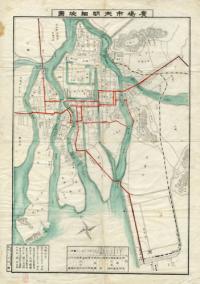
December 1894 / Published by Kamata Kinjiro / Collection of the Hiroshima Municipal Archives
11 The View from Mt. Futaba, Around 1877

Around 1877 / Photo / Collection of Archives and Mausolea Department, the Imperial Household Agency
12 The View from Mt. Futaba, Around 1921

Around 1921 / Picture postcard / Collection of the Hiroshima Municipal Archives
13 Ujina ; Port of Embarkation for Troops to China

1894 / Picture postcard / Collection of the Hiroshima Municipal Archives
14 The Imperial Headquarters Building
The Imperial Headquarters located at Hiroshima Castle in the First Sino-Japanese War.
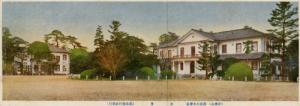
Late 1920s to 1945 / Picture postcard / Collection of the Hiroshima Municipal Archives
15 Army Facilities around Hiroshima Castle in 1927
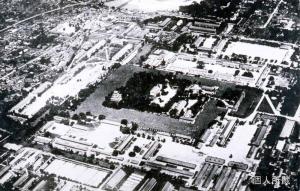
1927 / Photo
16 Military Drill of the Fifth Cavalry Regiment at the Eastern Drill Ground
In 1890, the Eastern Drill Ground of The Fifth Division was set up north of the Hiroshima Station area.
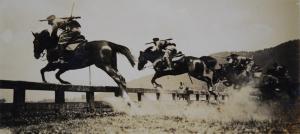
Before 1945 / Picture / Collection of the Hiroshima Municipal Archives
17 The Bird’s-eye View Map of Miyajima and Hiroshima
(“Miyajima-Hiroshima-meisyo-kotsu-zue” Transportation Map of Famous Sites in Miyajima and Hiroshima )

1928 / Published by Hiroshima Electric Railway Co. Ltd. / Illustration by Yoshida Hatsusaburo / Collection of the Hiroshima Municipal Archives
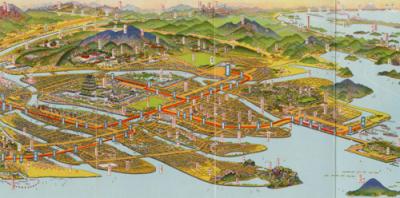
Hiroshima city area
With the First Sino-Japanese War and the Russo-Japanese War, new military facilities were built, and existing ones were expanded in Hiroshima City. The Fifth Division was established on the grounds of Hiroshima Castle and military facilities were concentrated in and around Hiroshima Castle, Hiroshima Station, and Ujina. By the end of the Pacific War, approximately 10% of the city was military land. When the Second Sino-Japanese War began, soldiers from all over Japan would be shipped off to war from Ujina Port, and soldiers being sent off could be seen all around the city.
The economy of Hiroshima was centered around munitions factories. However, the worsening war situation exacerbated the shortage of goods. Rationing systems for food and other goods began, and citizens were forced to endure with very little. In addition, students and women were also mobilized to work in military facilities and weapons factories to make up for the loss in the workforce.
Hardly any air raids were carried out on Hiroshima until the atomic bombing, so the city was left largely untouched. However, as air raids intensified on the mainland, Hiroshima, too, took action: groups of students were evacuated to other regions, fire drills to prepare for air raids were carried out, and buildings were removed to create firebreaks by demolishing homes.
18 The View from the Head Office of Hiroshima-denki(present Chugoku Electric Power Co. Inc.), at Ko-machi.
The north view from the center of Hiroshima, near the City Hall.
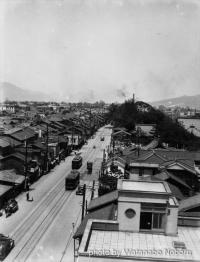
May 22, 1935 / Photo by Watanabe Noboru / Collection of the Hiroshima Municipal Archives
19 Street Map of Hiroshima City in 1939
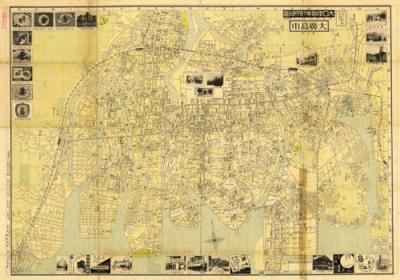
1939 / Published by Tokyo-kotsu-sha / Map / Collection of the Hiroshima Municipal Archives
20 Sending Soldiers to War
The soldiers of the Fifth Division stationed in Hiroshima were sent to the front from Hiroshima Port. Local residents who had come to bid them farewell could be seen around the city.
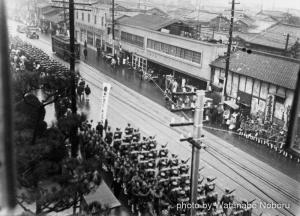
April 8, 1936 / Photo by Watanabe Noboru / Collection of the Hiroshima Municipal Archives
21 Fire Drills with Bucket Relays Against Air-Raids
About a year before the atomic bombing, there was a fire drill in which bucket relays were used to prepare for air raids.
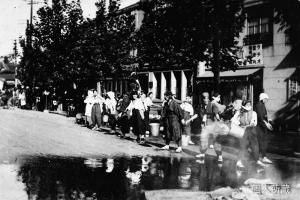
1944 / Photo / Courtesy of Hayashi Yuzo
22 Students Mobilized to Work at the Hiroshima Army Ordnance Supply Depot
As military mobilization increased, domestic labor shortages led to the enforcement of junior high and high school students to work in military factories.
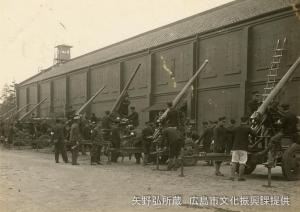
During the Pacific War / Photo / Collection of Cultural Promotion Division, City of Hiroshima
23 Children Cropped a Field in the Schoolyard
Because of a shortage of workers in agriculture, food production plummeted. Schoolyards were utilized to grow vegetables and raise hogs in order to supplement the food supply.
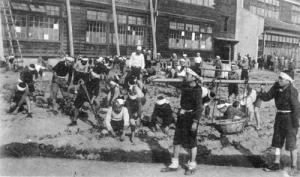
During the Pacific War / Graduation memorial album of Nobori-cho Elementary School published in March 1945 / Collection of the Hiroshima Municipal Archives
24 Nobori-cho Elementary School Children Evacuated to a Temple
Due to intensifying air raids in 1944, an evacuation program relocated city-dwelling elementary school children to the countryside for safety. Nobori-cho Elementary School children at the center of the City sought refuge at a countryside temple in April 1945. The photo depicts a heartwarming reunion meal with parents. Sadly, many became atomic bomb orphans.
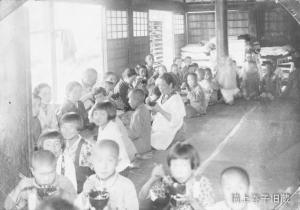
1945 / Photo
<Online Exhibition> The Birth of Hiroshima, Peace Memorial City
PART1
Contact us if you would like to ask about these images.
Contact Information
Hiroshima Municipal Archives
4-1-1 Ote-machi, Naka-ku, Hiroshima City, Japan 730-0051
FAX:082-542-8831
E-mail:koubun@city.hiroshima.lg.jp

